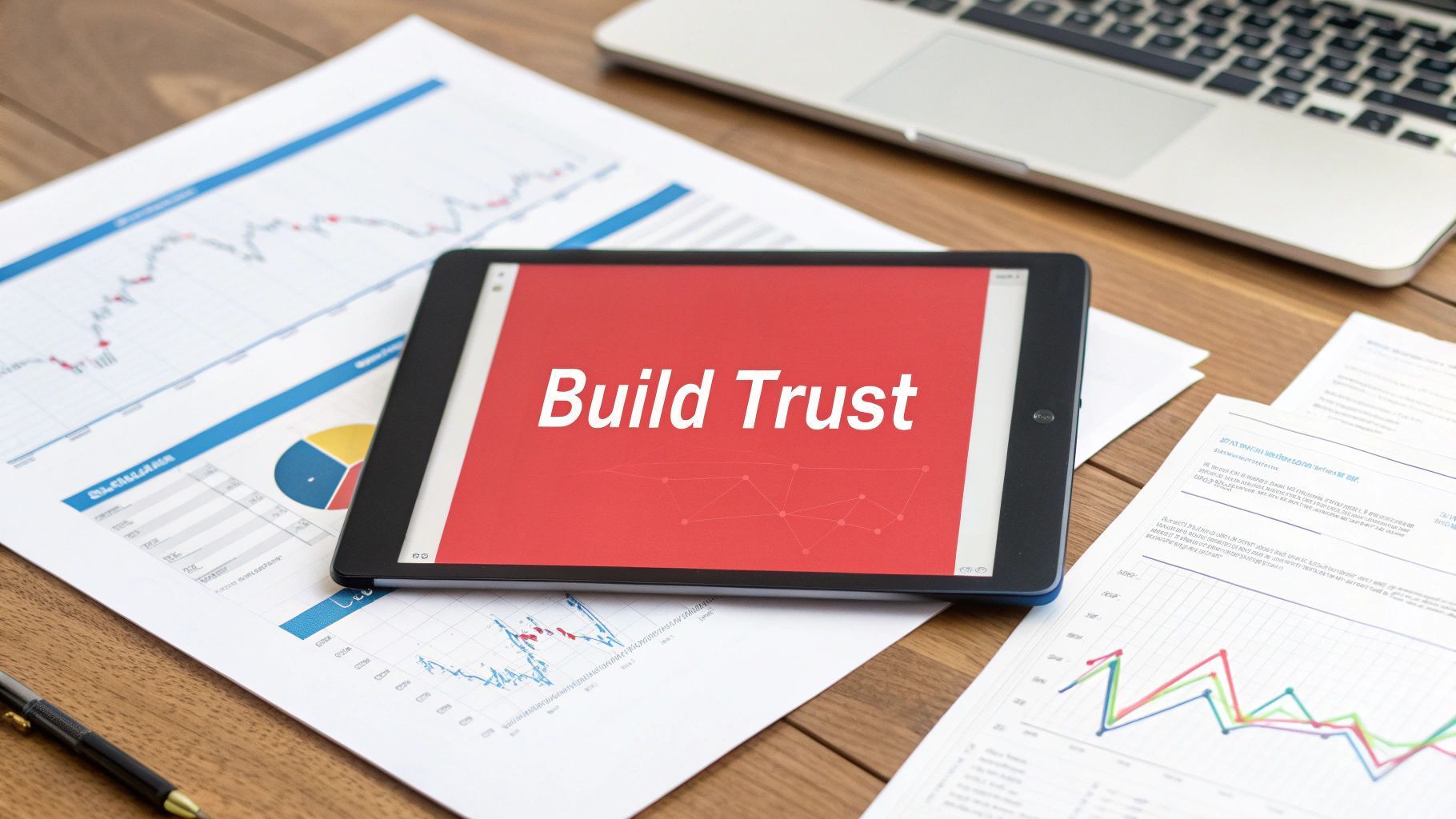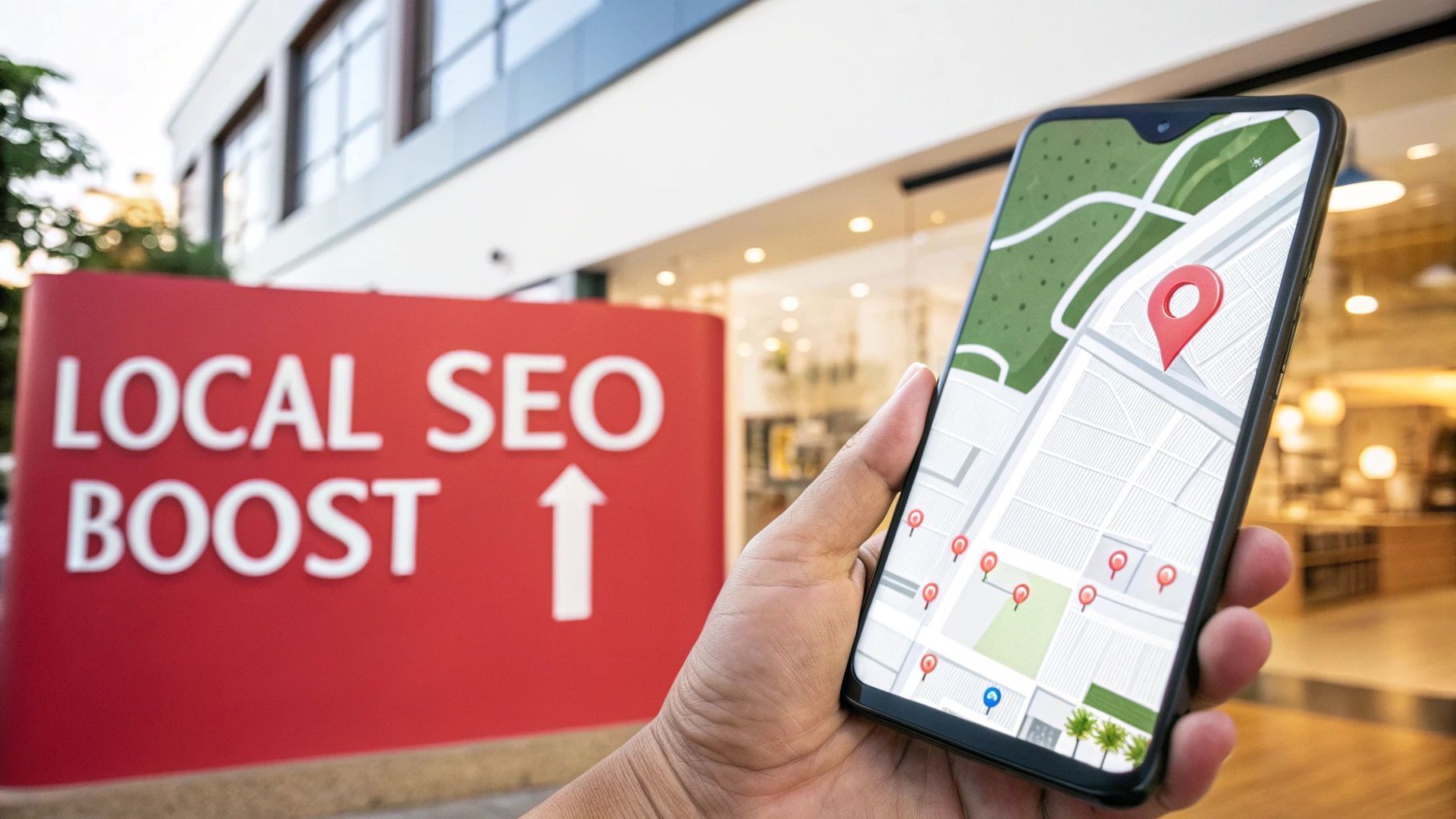What Is Conversion Rate Optimisation? Boost Your Website's Performance
Let's be honest, getting people to your website is only half the battle. What they do once they get there is what really matters. That’s where Conversion Rate Optimisation , or CRO for short, comes into play.
This isn’t about throwing ideas at the wall and hoping something sticks. It’s a methodical way of increasing the percentage of visitors who take the specific action you want them to take, using real data and user feedback to make smart improvements.
What Is Conversion Rate Optimisation?
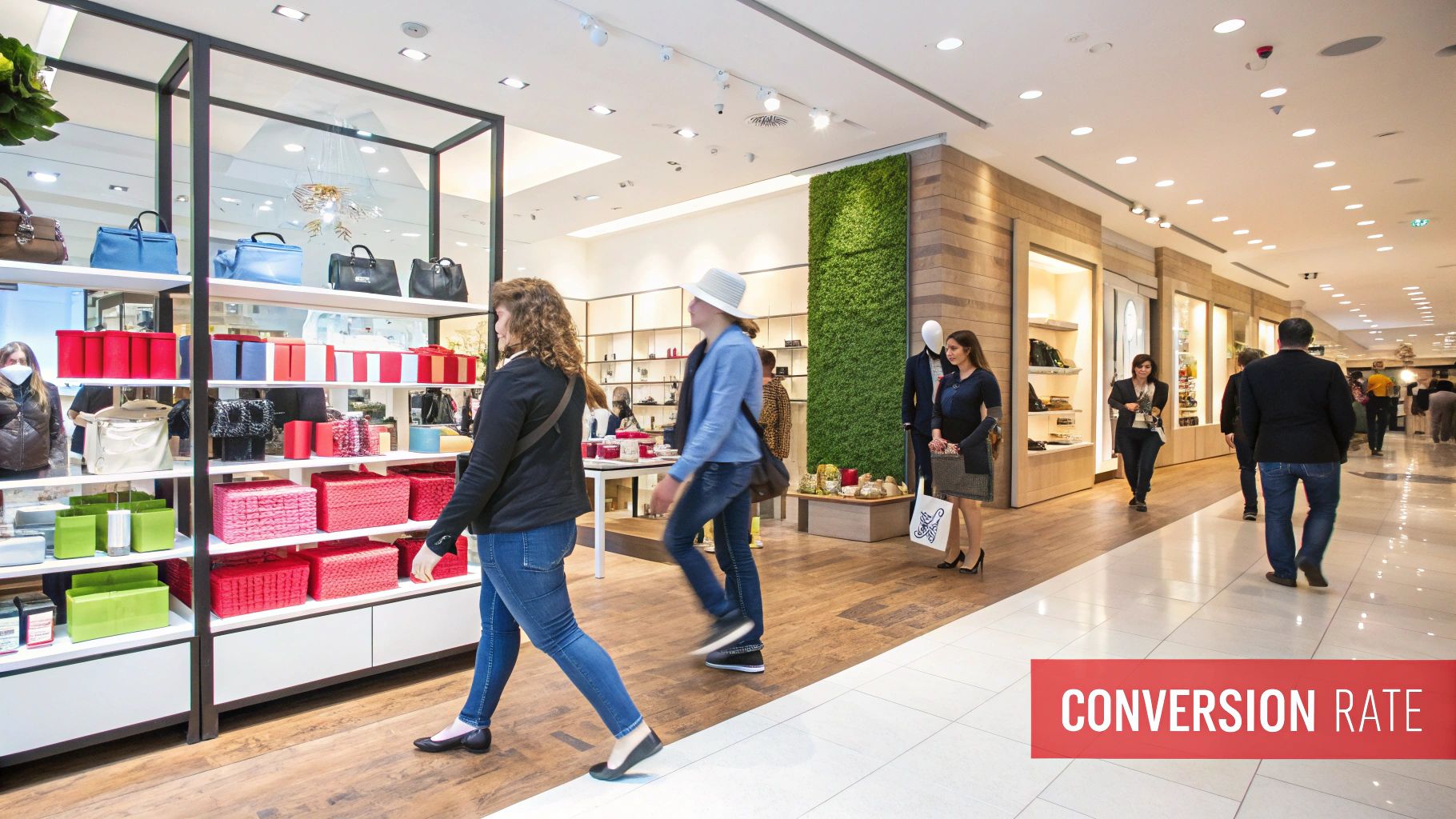
Think of your website like a high street shop. You’ve done the hard work to get people through the door (that’s your traffic), but not everyone who wanders in makes a purchase. CRO is the art of tweaking your shop’s layout, making your product displays more appealing, and ensuring the checkout queue moves smoothly to convince more browsers to become buyers.
It’s a structured approach, not a one-off redesign based on a hunch. It’s about digging into analytics and understanding user behaviour to see how people actually interact with your site. The goal? Pinpoint the roadblocks stopping them from converting, and then test changes to tear those barriers down.
If you're running an online store, these ecommerce conversion rate optimisation strategies offer a great deep dive into this systematic process.
So, What Counts As A Conversion?
The term ‘conversion’ is pretty flexible – it’s simply whatever key action you need a user to take to meet your business goals.
- For an ecommerce shop , the most obvious conversion is a sale.
- For a B2B business , it might be someone filling out a contact form or downloading a guide.
- For a media site , it could be as simple as a newsletter sign-up.
CRO is all about making it dead simple for your visitors to complete these actions. It's how you squeeze more value out of the traffic you already have.
To make these ideas a bit more concrete, here’s a quick rundown of the core concepts you'll come across in the world of CRO.
Key CRO Concepts at a Glance
| Concept | Brief Explanation | Why It Matters |
|---|---|---|
| A/B Testing | Showing two versions of a webpage to different users to see which performs better. | It provides hard data on what works, removing guesswork from design changes. |
| User Journey Map | A visual representation of a customer's interactions with your site from start to finish. | Helps you spot friction points and moments of frustration that kill conversions. |
| Call-to-Action (CTA) | A button or link prompting users to take a specific action (e.g., "Buy Now," "Sign Up"). | The design, wording, and placement of a CTA can dramatically impact click-through rates. |
| Heatmaps | Visual data showing where users click, move their mouse, and scroll on a page. | Reveals what grabs attention and what gets ignored, offering clues for improvement. |
Understanding these basics is the first step towards building a more effective, user-friendly website that turns visitors into customers.
At its core, CRO is about understanding what drives, stops, and persuades your users, so you can give them the best user experience possible. This focus on the user is what turns casual browsers into loyal customers.
Ultimately, CRO isn’t just a nice-to-have; it's a fundamental part of any serious digital strategy. By constantly refining the user journey, you don't just give your metrics a lift—you build a website that works better for everyone. It’s the difference between just getting traffic and turning that traffic into real, tangible results for your business.
Why CRO Is a Game-Changer for Your Business
Okay, so we know what conversion rate optimisation is. But why should you actually care?
It's simple, really. CRO is one of the most powerful levers you can pull to grow your revenue without spending a single extra penny on ads. It’s all about getting more out of the website visitors you already have.
Think of it like this: you could double your ad budget to try and double your traffic. Or, you could double your conversion rate and double your revenue from the exact same traffic. Which one sounds smarter? It's a far more sustainable and cost-effective way to grow, making every pound you spend on marketing work harder.
Unlocking More Value from Your Existing Traffic
So many businesses get stuck on a hamster wheel, constantly chasing new customers whilst completely ignoring the experience of the people already on their site. CRO flips that script. It forces you to focus on making the user's journey better.
When you remove the little friction points and make it dead simple for people to do what they came to do, more of them will naturally convert. It’s not rocket science.
For a UK ecommerce business, the impact is huge and immediate. Let's say you have an online shop with 20,000 visitors a month and a 1.5% conversion rate. Nudging that up to just 2% might not sound like a big deal, but it adds up to 100 extra sales every single month. That's real money, all from the same amount of traffic.
Conversion Rate Optimisation isn’t just a marketing tactic; it's a core business strategy that turns your website into your most effective salesperson, working 24/7 to turn interest into action.
This applies to any business. Whether you need more leads, more demo bookings, or more sales, CRO is the most direct path to getting there by making your website smarter, not just busier.
More Than Just a Revenue Boost
Whilst the money is a massive draw, CRO brings other strategic advantages that strengthen your entire business. It's a continuous cycle of learning and improving that pays dividends well beyond the balance sheet.
- You'll Understand Your Customers Better: CRO forces you to get inside your customers' heads. You learn what they actually care about, what annoys them, and what makes them click 'buy'. This is gold dust you can use to shape everything from your products to your marketing messages.
- A Better User Experience (UX): At its core, CRO is about creating a smooth, intuitive experience. A website that just works doesn't just boost conversions; it makes people want to come back and builds real loyalty.
- It Makes Your Brand Look Good: A site that’s easy to use shows you respect your customers' time. It tells them you care, which builds trust and makes you stand out in a crowded market.
And the numbers back this up. As of 2025 , the global average ecommerce conversion rate hovers around a modest 1.7% . This means even a tiny improvement can put you miles ahead of your competitors, turning small tweaks into a serious competitive advantage. You can dig into more 2025 e-commerce conversion rates on develodesign.co.uk.
Mastering the Core CRO Framework
Great conversion rate optimisation isn’t about throwing ideas at the wall to see what sticks. It's a disciplined, repeatable process that turns data into real, tangible improvements. Think of this framework as the engine that powers every effective CRO programme, giving you a structured path from insight to action.
At its heart, the CRO framework is a continuous cycle of learning and refinement. Each step flows logically into the next, making sure your efforts are always based on hard evidence, not just assumptions. When you follow this process, you create a reliable roadmap for constantly improving your website and boosting its performance over time.
This diagram breaks down the core stages of the conversion rate optimisation cycle.
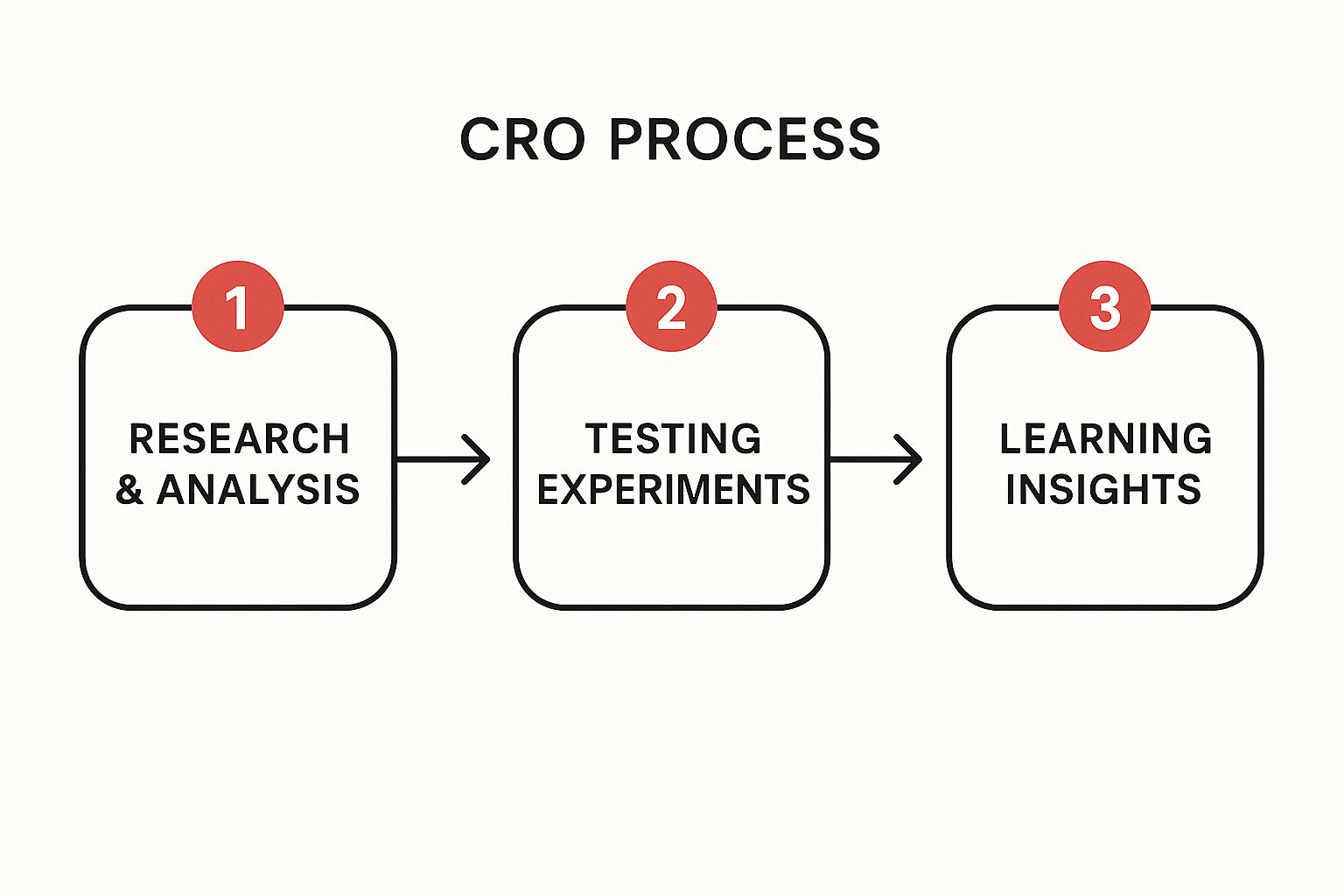
It shows how the process moves from initial discovery and research through to experimentation and analysis, creating a powerful loop of continuous improvement.
Research and Analysis
This is where you put on your detective hat. Your mission is simple: understand how users actually behave on your site and pinpoint the friction points that stop them from converting. You're not looking for solutions just yet; you're gathering clues.
You'll need a mix of tools to get the full picture:
- Quantitative Data: Dive deep into your analytics to see what is happening. Look for the pages with surprisingly high drop-off rates or the exact spots where users abandon their journey.
- Qualitative Data: Use tools like heatmaps and session recordings to understand why it's happening. Watch how real people click, scroll, and move around to spot signs of confusion or frustration.
Developing a Hypothesis
Once you’ve gathered your evidence, it's time to form an educated guess. A hypothesis is a clear, testable statement that proposes a change and predicts a specific outcome. It’s built on a simple structure: "If I change [X], then [Y] will happen, because [Z]."
For example, your hypothesis might sound like this: "If we change the call-to-action button on our product page from 'Learn More' to 'Buy Now', then click-throughs will increase, because the new text creates a much stronger sense of urgency." This clarity is absolutely vital for the next steps. To learn more about building pages that convert, check out our guide on the anatomy of a high-converting landing page.
Prioritisation and Testing
You’ll probably end up with dozens of great hypotheses, but you can't test them all at once. Prioritisation is all about deciding which tests offer the biggest potential impact for the least amount of effort. This step makes sure you’re focusing your resources where they’ll deliver the most value, fast.
With your priority list locked in, you can move on to testing. This is where you run controlled experiments—most commonly A/B testing —to see if your hypothesis was on the money. You show one version of the page (the control) to one group of users and the modified version (the variation) to another, then measure which one performs better against your goals.
The goal of testing isn't just to find a 'winner'. It's to validate your understanding of user behaviour and learn what truly motivates your audience to take action.
Learning and Iterating
The final stage is all about analysing the results. Did your change produce the effect you predicted? Whether the test won, lost, or had no impact at all, you've learned something incredibly valuable about your audience.
These new insights are then fed straight back into the research phase, fuelling the next cycle of optimisation. It’s this continuous loop that makes CRO such a powerful engine for sustainable business growth.
Decoding the Data That Drives Decisions

Good CRO is built on data, but knowing which numbers actually matter is a different game altogether. It’s far too easy to drown in a sea of analytics.
The trick is to focus on the metrics that tell the real story of how people are behaving on your website. These are the numbers that reveal where your best opportunities are hiding.
When you look beyond just your overall conversion rate, you can start to diagnose specific problems. Think of yourself as a website doctor; these metrics are the symptoms pointing you towards the cure. Each one is a clue, a hint about what your users are thinking and where they’re getting stuck.
The Performance Metrics You Should Actually Monitor
To get a true feel for performance, you need to track a handful of core metrics. They don't exist in a vacuum; they all influence each other and, together, paint a pretty clear picture of your user experience.
-
Bounce Rate: This is the percentage of people who land on a page and leave without doing anything else. A high bounce rate isn't just a number—it’s a warning sign. It could mean your messaging is off, the design is putting people off, or the page just isn't what they expected to find.
-
Exit Rate: This one’s simple but powerful: it shows you the very last page a user saw before leaving your site. A low exit rate on your order confirmation page? Fantastic. But a high exit rate on the first page of your checkout? You’ve just found a major leak that’s costing you sales.
-
Average Session Duration: How long do visitors stick around? That's what this metric tells you. Longer sessions can be a great sign of engagement, but context is everything. Someone spending ages on a detailed blog post is great news. Someone spending ages on a simple contact form probably means it’s a nightmare to fill out.
-
Cart Abandonment Rate: For any ecommerce site, this is a critical health check. It's the percentage of shoppers who add items to their cart but disappear before paying. The culprit is often unexpected shipping costs, a clunky checkout process, or a page that just doesn't feel trustworthy.
By digging into these specific metrics, you stop just knowing that you have a problem. You start understanding where and why it's happening. This is the bedrock of building solutions that actually work.
Analyse Where Your Traffic Comes From
Let’s be honest, not all website traffic is created equal. Understanding where your visitors are coming from is a game-changer because every channel brings in people with a completely different mindset.
When you start analysing conversions by traffic source, you can focus your optimisation efforts where they’ll have the biggest impact.
For example, direct traffic—the people who type your URL straight into their browser—almost always has the highest conversion rate. They already know you, they trust you. In fact, UK data shows that direct traffic converts at an average of 3.3% , which is higher than any other source. This strongly suggests that businesses with real brand recognition get the biggest wins from CRO. You can discover more about UK conversion rates on bloggingwizard.com.
On the other hand, traffic from social media might need a bit more convincing. These visitors are often just casually scrolling and need to be persuaded to take action. By segmenting your data, you can start tailoring the experience for each audience, creating a much smoother path to conversion.
Proven Strategies to Increase Conversions
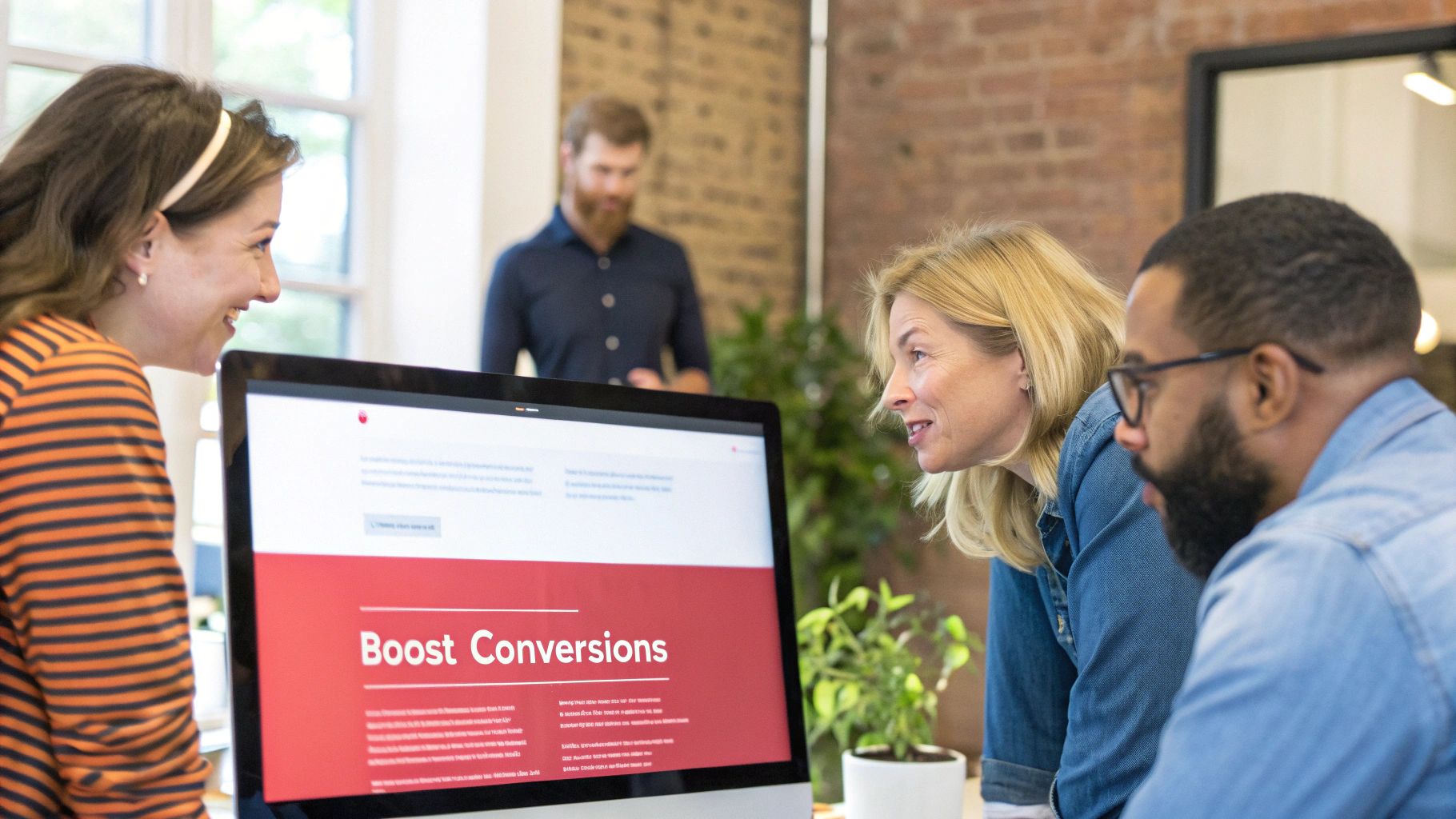
So, you’ve got a handle on the CRO framework and you know which data points to watch. Now for the exciting part: turning those insights into action. It’s time to start testing some practical, proven tactics that are known to lift conversion rates.
These aren't just random stabs in the dark. Each strategy is rooted in solid principles of user experience and persuasion, designed to smooth over a point of friction or give a user’s motivation a nudge in the right direction. It's all about making the path to conversion feel effortless.
The trick is to focus your efforts. By homing in on one area of your website at a time, you can run much cleaner tests and get a clearer picture of what actually makes a difference to your audience.
Optimise Your Landing Pages
Your landing pages are often a visitor's first handshake with your brand, so you need to make them count. The mission is simple: deliver exactly what the user came for, with zero confusion.
- Write Compelling Headlines: Your headline needs to instantly tell visitors they’re in the right place. It should scream value. Test different versions to see what grabs your audience.
- Create Clear Calls-to-Action (CTAs): Your CTA button should be the most obvious thing on the page. Use a colour that pops and swap passive text like "Submit" for something action-focused, like "Get Your Free Quote".
Improve Site Navigation and Flow
A confusing website is a conversion killer. Full stop. If people can't find what they want quickly, they'll just leave. A frictionless journey is what conversion rate optimisation is all about.
Think of your site’s navigation like signposts in a shop – they need to be clear, logical, and helpful. Keep your main menu organised, use breadcrumbs on deeper pages, and make sure your search bar actually works. Every click should feel like a step closer to their goal. For a deeper dive, you can learn more about how to improve website conversion rates for UK businesses in our dedicated guide.
Social Proof is Your Ally: People trust other people. Weaving in customer testimonials, reviews, and case studies builds instant credibility and dials down the perceived risk of a purchase or sign-up.
Simplify Your Forms
Nobody likes filling out long, complicated forms. They are a massive source of user frustration. For every extra field you add, you’re increasing the odds that someone will give up and walk away.
Keep your forms as short as humanly possible. Only ask for what you absolutely need right now. Use clear labels for each field and provide helpful, human-sounding error messages if something isn’t right. Just showing that you respect a user's time can have a huge impact on how many people complete them.
Streamline the Checkout Process
For any ecommerce site, the checkout is the final hurdle. It’s where the money is made, but it's also where most people drop off. Industry data shows that nearly 70% of online shopping carts are abandoned. Making this process smoother is one of the highest-impact changes you can make.
- Offer a Guest Checkout: Don’t force people to create an account just to buy something.
- Be Transparent with Costs: Show all costs, including shipping, right from the start. No nasty surprises.
- Provide Multiple Payment Options: People have their preferences. Cater to them by offering various payment methods.
To explore more ecommerce specific tactics, this resource on How to Improve Ecommerce Conversion Rates offers some excellent, actionable advice. By methodically testing these strategies, you can begin to build a website that doesn’t just attract visitors, but reliably turns them into customers.
Building Your Essential CRO Toolkit
Turning all that data and strategy into real-world results needs the right equipment. To get a successful conversion rate optimisation programme off the ground, you need a toolkit that helps you understand what users are really doing, test your best ideas, and measure what actually works.
Think of it like being a detective. First, you gather clues to figure out what’s happening. Then, you need the right gear to analyse the evidence and, finally, a solid method to test your theories. A proper CRO toolkit works the same way, giving you a complete picture of your website's performance from every possible angle.
Web Analytics Platforms
This is where it all begins—the absolute foundation of any CRO work. Web analytics tools give you the hard numbers, the quantitative data that shows you the what and where of user behaviour. They track traffic, bounce rates, exit pages, and conversion funnels, revealing the critical stats behind how your website is performing.
-
Google Analytics: The industry go-to. It’s a powerful, free way to track user journeys and pinpoint exactly where visitors are dropping off.
-
Adobe Analytics: A more enterprise-level choice, known for its incredible depth in segmentation and customisation. It's built for seriously complex data analysis.
These platforms are your first port of call for spotting trends and identifying the pages that are crying out for your attention.
User Behaviour Tools
Analytics tells you what is happening, but user behaviour tools are all about the why. These tools give you qualitative insights by showing you how real people move, click, and scroll around your site. They add the human context that the numbers just can't provide. Understanding this is everything, and you can dive deeper by exploring how to master user experience design principles for better UX.
These tools let you see your website through your customers' eyes, uncovering the friction points and moments of pure confusion that analytics data alone will never show you.
A couple of the most popular tools here are:
- Hotjar: Famous for its heatmaps (which visually show clicks and scrolls) and session recordings that let you watch entire user journeys as if you're looking over their shoulder.
- Crazy Egg: Another brilliant contender offering heatmaps, scroll maps, and other visual reports to help you decode what people are doing on the page.
A/B Testing Platforms
Right, so you've got a hypothesis based on all your data. Now what? You need to test it scientifically. A/B testing platforms are designed for exactly that. They let you run controlled experiments, showing different versions of a page to different groups of your audience to see which one genuinely performs better.
The UK’s CRO tools market is on track to hit £5 billion by 2025 , and it’s platforms like Optimizely and VWO that are driving this growth with sophisticated testing and personalisation features. UK brands using these tools are often reporting conversion lifts of 10–30% year on year. If you're interested, you can read the full research about CRO statistics on sqmagazine.co.uk.
Ultimately, these tools take the guesswork out of the equation, making sure your decisions are based on cold, hard evidence.
Your CRO Questions Answered
Let's get into the questions that always come up when businesses first start looking at conversion rate optimisation. This is where the theory stops and the practical reality of putting a CRO strategy into action begins.
Most of the time, these questions are about timelines, targets, and how much it’s all going to cost. Getting clear on this stuff from the start is vital before you dive in.
How Long Until I See Results From CRO?
This is the big one, and the only honest answer is: it depends. Conversion rate optimisation is a marathon, not a sprint. Sure, you might get lucky with a single A/B test that shows a quick lift in a few weeks, but the real, game-changing value comes from the snowball effect of continuous testing and learning over months.
The speed of your results really hinges on your website's traffic. A site with thousands of daily visitors can gather solid data much faster than a smaller one. The trick is to stop thinking of CRO as a project with a finish line. It's an ongoing business process that builds on itself over time.
What Is a Good Conversion Rate?
There's no magic number here. Whilst industry benchmarks can give you a rough idea, they're often a distraction because they don’t account for your specific business, audience, or price point. A 2% conversion rate might be incredible for a company selling high-end bespoke furniture, but terrible for another selling cheap digital downloads.
Instead of chasing someone else’s number, focus on your own performance. A 'good' conversion rate is one that is getting better month on month, driven by your own tests and insights.
Your only goal should be to beat your last record, not to measure up against a vague industry average.
Can I Do CRO on a Small Budget?
Absolutely. You don't need a huge budget to start seeing real improvements. The most important part of CRO is simply understanding your users, and many of the best tools for that are completely free.
- Start with free tools: Google Analytics is a goldmine of data, and free versions of tools like Hotjar can give you game-changing heatmaps and session recordings to see what users are actually doing.
- Focus on high-impact areas: Use that data to find the biggest leaks in your sales funnel. Fixing a clunky, broken checkout page is going to give you a much bigger win than tweaking the font on a low-traffic blog post.
You can get fantastic results by starting small, proving the value, and then reinvesting the returns into more advanced tools and bigger tests down the line.
Ready to turn your website's potential into profit? At Superhub , we build data-driven strategies that deliver real results. Explore our services and find out how we can help you grow at https://www.superhub.biz.

